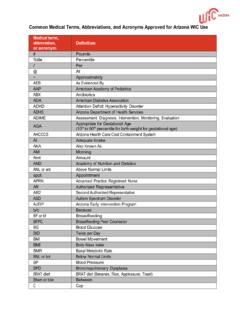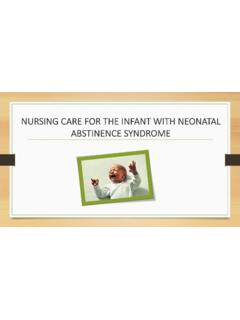Transcription of 2018 ARIZONA OPIOID PRESCRIBING GUIDELINES
1 ARIZONA OPIOID PRESCRIBING GUIDELINES2018A voluntary, consensus set of GUIDELINES that promote patient safety and best practices if PRESCRIBING opioids for acute and chronic This document should not be used to establish any standard of care or any deviation or variance from an accepted standard of care; nor should it be used solely to establish any health insurance coverage or determination. No legal proceeding, including medical malpractice proceedings or disciplinary hearings, should reference a deviation or variance from any part of this document as evidence of a breach of professional conduct, health insurance coverage policy or determination, or evidence that a deviation or variance from any part of this document demonstrates negligence, misconduct, errors or omissions, or breach of contract in the rendering of health care. These voluntary GUIDELINES are an educational tool for providers, meant to promote informed management of Arizonans with acute and chronic pain.
2 Clinicians should use their own independent clinical judgment and consider but not base clinical decisions solely on this document. The following GUIDELINES are founded on the best available evidence, national guidance, and ARIZONA -specific data on OPIOID overdoses. self-management strategies, non-pharmacologic treatments and non- OPIOID medications as the preferred treatment for chronic not initiate long-term OPIOID therapy for most patients with chronic interdisciplinary care for patients with high-impact chronic pain to address pain, substance use disorders and behavioral health non- OPIOID medications and therapies as first-line treatment for mild and moderate acute opioids are indicated for acute pain, initiate therapy at the lowest effective dose for no longer than a 3-5 day duration; reassess if pain persists beyond the anticipated not use long-acting opioids for the treatment of acute GUIDELINES FOR THE TREATMENT OF ACUTE AND CHRONIC PAINT here are more than two Arizonans dying every day from an OPIOID overdose, and the majority of deaths are due to prescription opioids.
3 It is imperative that ARIZONA clinicians have PRESCRIBING practices that maintain safety for their patients and community, while also addressing their patients pain. The following seventeen GUIDELINES for non-cancer, non-terminal pain are designed to provide information and assist decision-making for providers. Each patient and clinical presentation is unique, however, and these statements must not supersede medical judgment and risk-benefit PAINCHRONIC PAIN7 For patients on long-term OPIOID therapy, document informed consent which includes the risks of OPIOID use, options for alternative therapies and therapeutic boundaries. 8Do not use long-term OPIOID therapy in patients with untreated substance use concurrent use of opioids and benzodiazepines. If patients are currently prescribed both agents, evaluate tapering or an exit strategy for one or both the ARIZONA Controlled Substances Prescription Monitoring Program before initiating an OPIOID or benzodiazepine, and then at least reproductive plans and the risk of neonatal abstinence syndrome and other adverse neonatal outcomes prior to PRESCRIBING opioids to women of reproductive opioids are used to treat chronic pain, prescribe at the lowest possible dose and for the shortest possible time.
4 Reassess the treatment regimen if PRESCRIBING doses 50 patients who are taking opioids on safety, including safe storage and disposal of medications, not driving if sedated or confused while using opioids and not sharing opioids with others. 14 Reevaluate patients on long-term OPIOID therapy at least every 90 days for functional improvements, substance use, high-risk behaviors and psychiatric comorbidities through face-to-face visits, PDMP checks and urine drug patients on long-term OPIOID therapy on a regular basis for OPIOID use disorder and offer or arrange for medication-assisted therapy ( methadone and buprenorphine) to those diagnosed. 16 Offer naloxone and provide overdose education for all patients at risk for OPIOID overdose. 17 Individualize a careful exit strategy from the use of long-term OPIOID therapy for chronic pain, when indicated by a risk MITIGATION 3 TABLE OFCONTENTSD isclaimer Purpose of the GuidelinesUpdates to the GuidelinesIntended Audience and ScopeGlossary of TermsSummary GUIDELINES for the Treatment of Acute and Chronic PainElaborated GUIDELINES for the Treatment of Acute and Chronic PainAppendicesA: How to implement these GUIDELINES into clinical flowB: How to manage an inherited patient on OPIOID therapyC: How to evaluate patients for OPIOID use disorderD: How to connect patients with medication-assisted treatment E: How to approach an OPIOID exit strategy F: How to manage pain and opioids in special populations G: How to connect with local and national resources H.
5 How to correct clinical misperceptions about opioids ReferencesAcknowledgments44456 816424714 PURPOSE OF THE GUIDELINESThe Centers for Disease Control and Prevention (CDC) has described an OPIOID epidemic in the United States. Overdoses involving heroin, fentanyl and prescription opioids killed more than 33,000 people in the United States in 2015. Nearly half of those deaths were from prescription opioids. The ARIZONA Department of Health Services has found that more than two Arizonans die every day from an OPIOID overdose, the majority from prescription opioids. Prescription opioids are used routinely in ARIZONA , with over 205 million OPIOID pills prescribed between January and July 2017, enough for every resident to have a 30-pill supply. In addition to overdose fatalities, there are many times those numbers of nonfatal OPIOID overdoses reported to the Department, along with daily reports of suspected neonatal abstinence syndrome.
6 PRESCRIBING practices have contributed to the current OPIOID crisis and a shift in PRESCRIBING culture, approach to pain and recognition of substance use disorders is needed. The following ARIZONA OPIOID PRESCRIBING GUIDELINES aim to reduce overreliance on OPIOID therapy, make safety a priority in managing acute and chronic pain, and increase awareness of treatment of OPIOID use disorder. These GUIDELINES reflect the best available evidence and local data, and can assist in clinical decision-making for ARIZONA providers. It is recognized that access to recommended options may be limited by availability and TO THE GUIDELINESThis is the second edition of the ARIZONA OPIOID PRESCRIBING GUIDELINES . One of the deliverables from the 2017 State of Public Health Emergency, as declared by ARIZONA Governor Doug Ducey, was to update the 2014 GUIDELINES for ARIZONA clinicians. Current updates reflect:1.
7 Incorporation of the most recent evidence, national GUIDELINES (including the VA/DoD Clinical Practice Guideline for OPIOID Therapy for Chronic Pain, 2017 and CDC Guideline for PRESCRIBING Opioids for Chronic Pain, 2016), best practices from other states and ARIZONA data. Most references are recent, and guided the inclusion of newer concepts such as high-impact chronic pain, complex persistent OPIOID dependence and OPIOID exit strategies. 2. A shift in pain care that avoids unnecessary exposure to opioids in order to reduce the risk of adverse outcomes. Previous GUIDELINES focused on the safe PRESCRIBING of OPIOID therapy, while these GUIDELINES aim to prevent initiating unnecessary OPIOID therapy while addressing patients pain from a whole-person perspective. 3. Emphasis on nonstigmatizing language. Health care providers can counter stigma by using accurate, nonjudgmental language. These GUIDELINES employ person-first language ( Patients with substance use disorder instead of addicts ), nonjudgmental terminology ( negative urine drug test instead of dirty ) and supportive terms ( recovery instead of no cure ).
8 4. Increased focus on prevention, recognition, and treatment of OPIOID use disorder in patients receiving long-term OPIOID therapy for chronic pain, given the high risk of developing OPIOID use disorder in this population. 5. Integration into clinical workflow (operationalization). A key element of success of guideline implementation is how seamlessly it can be incorporated into a clinician s normal activities. This revised version includes specific operationalization actions under each guideline, and summarizes them in Appendix A. The tone is also purposely direct and actionable, rather than passive. INTENDED AUDIENCE AND SCOPE The ARIZONA OPIOID PRESCRIBING GUIDELINES (2018) are intended for use by clinicians in primary care and outpatient settings who provide care to patients receiving treatment for acute and chronic pain that is not occurring at the end of life or after complex surgery, and is not due to an active malignancy.
9 They may also be used by hospitals, outpatient surgical centers, behavioral health inpatient facilities and nursing care institutions for the management of pain upon OF TERMS ACUTE PAIN: pain lasting less than 90 : a primary, chronic disease of brain reward, motivation, memory and related circuity. Dysfunction in these circuits leads to characteristic biological, psychological, social and spiritual manifestations. Addiction is characterized by the inability to consistently abstain, impairment in behavioral control, craving, diminished recognition of significant problems with one s behaviors and interpersonal relationships, and a dysfunctional emotional STATE BOARD OF PHARMACY CONTROLLED SUBSTANCES PRESCRIPTION MONITORING PROGRAM (AZ CSPMP): ARIZONA s Prescription Drug Monitoring ASSESSMENT: a comprehensive assessment of co-occurring medical and psychiatric conditions, personal and family history of substance use disorder, functional status and functional goals, coping strategies, and psychosocial factors such as the patient s beliefs and expectations about chronic pain and its : Centers for Disease Control and PAIN: pain persisting longer than 3-6 months and beyond the normal tissue healing PERSISTENT OPIOID DEPENDENCE.
10 The clinical and psychological state that exists on the continuum between simple OPIOID dependence (which presents with short-lived and self-limited withdrawal symptoms after opioids are discontinued) and OPIOID -use disorder. Symptoms of complex persistent OPIOID dependence can include worsening pain, patient reported function, affective symptoms, sleep disturbance and other protracted withdrawal symptoms upon OPIOID dose reduction or : Food and Drug IMPACT CHRONIC PAIN: chronic pain that is associated with substantial restriction of participation in work, social and self-care activities for six months or more. INFORMED CONSENT: patient-centered information about known benefits and harms of OPIOID THERAPY: OPIOID formulations that are Extended Release (ER) or Long Acting (LA).LONG-TERM OPIOID THERAPY: use of OPIOID -medications for more than 90 TREATMENT (MAT): use of medications, in combination with counseling and behavioral therapies, to provide a whole-patient approach to the treatment of substance use disorders.















